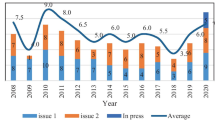Abstract
Attempts to reduce the multiplicity and variety of the range of indicators presently used to measure science and technology to lean patterns have so far proved unsuccessful.
The reason for this is the ongoing lack of an all-comprehensive theory to rationalise every aspect of intricate and as yet obscure processes such as scientific discovery and technological innovation. We ought to expect from a theory of scientific and technological progress satisfactory not only in abstract terms but also as an empirical analysis is a composition of two aspects — static and dynamic — in a few homogeneous variables.
Similar content being viewed by others
References
R. Solow, Technical change and the aggregate production function,Review of Economics and Statistics, 39 (1957) 312–320.
E. Mansfield, Academic research and industrial innovation,Research Policy, 20 (1991) 1–12.
S. Jacobsson, C. Oskarsson, Educational statistics as an indicator of technological activity,Research Policy, 24 (1995) 127–136.
E. Ehrnberg, On the definition and measurement of technological discontinuities,Technovation, 15 (1995) 437–452.
W. Glanzel, The needs for standards in bibliometric research and technology,Scientometrics, 35 (1996) 167–176.
R. Sweeting, R. Davies, Industrial innovation and parallel accounting developments,Technovation, 15 (1995) 289–302.
P. Collins, S. Wyatt, Citations in patents to the basic research literature,Research Policy, 17 (1988) 65–74.
H. Moed, et al., The use of bibliometric data for the measurement of university research performance,Research Policy, 14 (1985) 131–149.
K. Pavitt, R&D, patenting and innovative activities,Research Policy, 11 (1982) 33–51.
K. Smith, Technological innovation indicators: experience and prospects,Science and Public Policy, 19 (1992) 383–392.
M. Koenig, A bibliometric analysis of pharmaceutical research,Research Policy, 12 (1983) 15–36.
F. Narin, Bibliometric analysis of U. S. pharmaceutical industry research performance,Research Policy, 17 (1988) 139–154.
M. Macioti, The power and the glory: a note on patents and scientific authors,Research Policy, 9 (1980) 104–114.
M. Albert, et al., Direct validation of citation counts as indicators of industrially important patents,Research Policy, 20 (1991) 251–259.
A. Balaban, How should citations to articles in high- and low-impact journals be evaluated, or what is a citation worth?,Scientometrics, 37 (1996) 495–498.
F. Narin, D. Olivastro, Linkage between patents and papers: an interim EPO/US comparison,Scientometrics, 41 (1998) 51–59.
F. Meyer-Krahmer, Recent results in measuring innovation output,Research Policy, 13 (1984) 175–182.
A. Kleinknecht, D. Bain,New concepts in innovation output measurement, Mc Millan, London, 1993.
G. Sirilli, The technological balance of payments as an indicator of technology transfer in OECD countries. The case of Italy,Technovation, 11 (1991) 3–25.
M. Doms, R. McGuckin, Trade in high technology products,Science and Public Policy, 19 (1992) 343–346.
G. Barbiroli, The elaboration of global performance indices for evaluating durable goods,Technovation, 9 (1989) 83–100.
I. Lakatos,The Methodology of Scientific Research Programmes, Cambridge University Press, 1978.
T. Kuhn,The Structure of Scientific Revolutions, The University of Chicago Press, London, 1970.
P. Vinkler, Model for quantitative selection of relative scientometric impact indicators,Scientometrics, 36 (1996) 223–236.
F. Narin, Technology indicators in strategic planning,Science and Public Policy, 19 (1992) 369–382.
E. Garfield, A. Welljams-Dorof, Citation data: their use as quantitative indicators for science and technology evaluation and policy -making,Science and Public Policy, 19 (1992) 321–327.
H. Moed, et al., A critical analysis of the journal impact factors of Angewandte Chemie and The Journal of the American Chemical Society. Inaccuracies in published impact factors based on overall citations only,Scientometrics, 37 (1996) 105–116.
Author information
Authors and Affiliations
Rights and permissions
About this article
Cite this article
de Marchi, M., Rocchi, M. Summing up approaches to the study of science and technology indicators. Scientometrics 46, 39–49 (1999). https://doi.org/10.1007/BF02766294
Received:
Issue Date:
DOI: https://doi.org/10.1007/BF02766294




